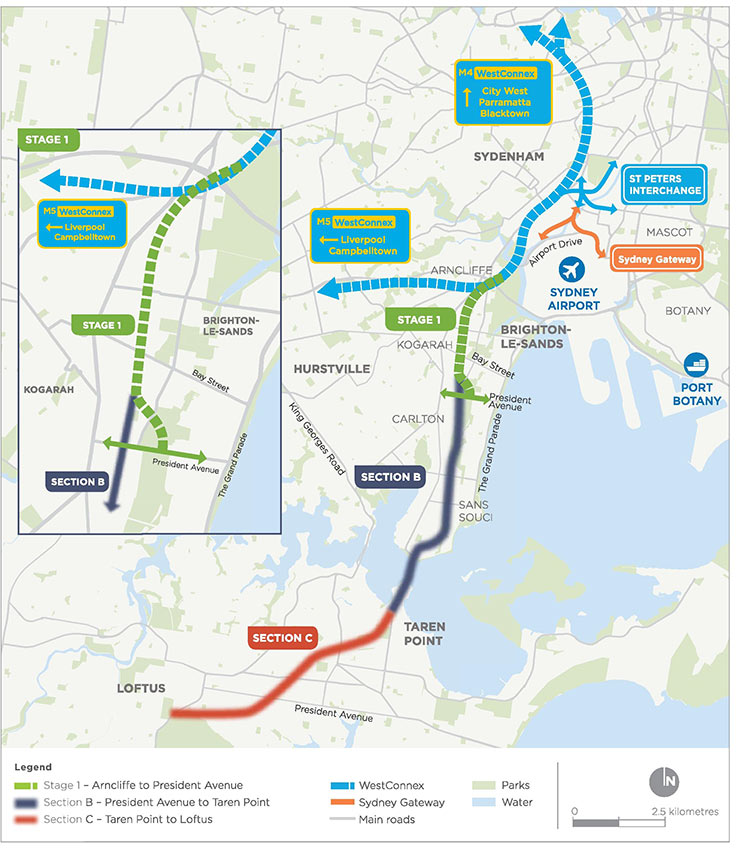TBMs in proposals for new M6 Sydney highway 03 Sep 2020
Proposals from three proponents are being evaluated for design-build construction of the 4km long underground Stage 1 section of the new M6 project as the next highway project for Sydney, Australia. The three JVs, selected as the successful applicants to the call for expressions of interest in October last year and invited to submit proposals in April this year (2020) include:
- The Gamuda - BMD Construction JV
- The CPB Contractors - Ghella - UGL JV
- A group led by Acciona
The new 4km long twin tube tunnel will link the new M8 underground motorway at Arncliffe, south to President Avenue at Kogarah (Fig 1). Tenderers are permitted to select their own method of excavation to meet a number of functional requirements and proposals include TBM options as well as the traditional roadheader excavations that have been used on all previous bored highway tunnels in Sydney.
The design-build contract is expected to be awarded in December 2020 with construction beginning by early 2022 and the new project open to motorists by the end of 2025.
The estimated AUD$2.6 billion M6 Stage 1 underground motorway will deliver a missing link in the Sydney highway network. It will offer travel time savings to the south and towards Illawarra with more than 2,000 trucks a day removed from local streets and 23 sets of traffic lights on the Princes Highway bypassed.
As well as the 4km long twin tube tunnels, the M6 Stage 1 project includes:
- Ramps between the main motorway tunnel and the surface intersection at President Avenue
- Tunnel stubs for a future connection south to extend the M6
- Motorway support infrastructure including tunnel ventilation systems and the motorway control centre
- New service utilities including a permanent power supply line
- Minor adjustments to local roads in the project area.
Before construction on the M6 Stage 1 starts, a programme of about $28 million in new and upgraded community and sporting facilities is being delivered to offset removal of some facilities for construction and staging areas. Work on upgrades to Ador Park and McCarthy Reserve at Rockdale, and at the Brighton Memorial Playing Fields at Brighton-Le-Sands, was set to start in mid-2020 and be finished by the end of 2021.
Providing better connectivity to the south of the Sydney city, the M6 will be delivered in three stages. Following the underground Stage 1 section, Section B is expected to run from Kogarah to Taren Point via Carlton and Sans Souci, while Section C will potentially run from Taren Point to the A1 Princes Highway in Loftus. There is currently no timeline, funding commitment or planning approval for Section B or Section C but the road corridor, reserved since 1951 for highway construction, remains in place. The project is classified by the New South Wales Government as State Significant Infrastructure and declared as Critical State Significant Infrastructure.
Stage 1 was approved for construction in December 2019 based on consideration of the environmental impact statement and the preferred infrastructure report, and responses to both, as well as community feedback. Conditions have been set to enhance public space, cycling and pedestrian connectivity, and to improve environmental outcomes, including:
- Stringent requirements to reduce noise during construction and provide noise mitigation measures early in the construction schedule
- Coordination of utility works to ensure adequate respite is provided to local communities
- Enhanced urban design and landscaping provisions
- Strict and transparent air quality provisions following advice provided by the Advisory Committee for Tunnel Air Quality, NSW Health, and the Environmental Protection Agency.
References
- Sydney opens new M8 underground highway – TunnelTalk, August 2019
- NorthConnex nears public opening – TunnelTalk, September 2020
- WestConnex final link awarded – TunnelTalk, December 2018
- Shortlist for start of Sydney Metro West route – TunnelTalk, August 2020
|
|
|
|
|
Add your comment
- Thank you for taking the time to share your thoughts and comments. You share in the wider tunnelling community, so please keep your comments smart and civil. Don't attack other readers personally, and keep your language professional.




